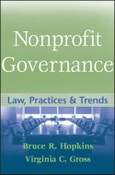Nonprofit Governance
Law, Practices & Trends
Governance seems to be the subject that is perched atop every nonprofit lawyer's worry/wish list, despite the fact that there is not much law on the point, particularly at the federal level. This ascension in importance is largely due to the various organizations propounding best practices and principles for public charities and other forms of nonprofit organizations, the IRS's redesigned Form 990, the agency's aggressive push of certain good governance principles in the tax-exempt organizations' setting, and scandals brought to light by the Senate Finance Committee staff.
Stemming from the authors' endless hours of meditating over the new Form 990 and sifting through the many (and often inconsistent) best practices principles, Nonprofit Governance fills the need for some cohesion in the realm of nonprofit governance by providing in-depth coverage and explanations of the laws, practices, and trends in this volatile area.
An invaluable resource for nonprofit executives, officers, directors, nonprofit lawyers, accountants, members of boards of directors, and consultants, legal experts Bruce R. Hopkins and Virginia Gross's Nonprofit Governance brims with detailed documentation and references to regulations, rulings, cases, and tax literature (which includes current articles and tax law review notes). Here, readers will find a wealth of clarifying information on:
- Federal and state law fundamentals
- Board member responsibilities and liability
- Nonprofit governance principles
- Nonprofit governance issues
- Application of the private benefit doctrine
- Governance and the redesigned Form 990
- Recommended polices and procedures
- Governance case studies
- Governance legal audit
- A law primer for nonprofit board members
- And much more
The book includes an exhaustive index, Internal Revenue Code citations and numerous case studies, tips, forms, and checklists to round out the authoritative coverage. Nonprofit Governance is an indispensable guide to, and through, all of the governance policymaking that is unfolding, to improve the management of nonprofit organizations as well as to help organizations be in compliance with nonprofit governance law.
Table of Contents
Book Citations xix
Preface xxi
Chapter One: Federal and State Law Fundamentals 1
1.1 State Law Overview 1
1.2 Formation of Organization 5
1.3 Board of Directors Basics 9
1.4 Principles of Fiduciary Responsibility 13
1.5 Duties of Directors 15
1.6 Board Composition and Federal Tax Law 16
Chapter Two: Board Members: Responsibilities and Liability 21
2.1 Board of Directors Governance Principles 21
2.2 Role of Officers 33
2.3 Key Employees 35
2.4 Management Companies 35
2.5 Board Member Responsibilities 36
2.6 Protections against Personal Liability 39
2.7 Minimizing Board Member Liability 41
Chapter Three: Nonprofit Organizations' Governance Principles 45
3.1 Governance Philosophy in General 45
3.2 Sarbanes-Oxley Act 46
3.3 Watchdog Agencies' Standards 51
3.4 California's Nonprofit Integrity Act 66
3.5 Senate Finance Committee Staff Paper 67
3.6 U.S. Treasury Department's Voluntary Best Practices 70
3.7 Committee for Purchase Proposed Best Practices 72
3.8 Panel on Nonprofit Sector Recommendations 73
3.9 Boards of Exempt Credit Counseling Organizations 74
3.10 Draft of IRS Good Governance Principles 74
3.11 American National Red Cross Governance Modernization
3.12 Panel on Nonprofit Sector Good Governance Principles 79
3.13 Redesigned IRS Annual Information Return (Form 990) 86
3.14 IRS LifeCycle Educational Tool Principles 86
3.15 Commentary 91
Chapter Four: Governance and the Redesigned Form 990 93
4.1 Governing Body and Management 94
4.2 Policies 104
4.3 Disclosure 108
Chapter Five: Nonprofit Governance Issues 111
5.1 Perspectives on Nonprofit Governance 111
5.2 Governing Board Size 113
5.3 Governing Board Composition 116
5.4 Role of Governing Board 121
5.5 Organization Effectiveness and Evaluation 124
5.6 Board Effectiveness and Evaluation 125
5.7 Frequency of Board Meetings 126
5.8 Term Limits 127
5.9 Board Member Compensation 129
5.10 Audit Committees 130
5.11 Other Committees 132
5.12 Compliance with Law 132
5.13 Categories of Expenditures 134
5.14 Disclosures to Public 136
5.15 Mission Statements 139
5.16 Codes of Ethics 140
5.17 Conflict-of-Interest Policies 141
5.18 Whistleblower Policies 144
5.19 Document Retention and Destruction Policies 145
5.20 Fundraising Practices 146
5.21 Role of IRS in Governance 148
Chapter Six: Policies and Procedures for Good Governance 157
6.1 Sources of Policies and Procedures 157
6.2 IRS Focus on Policies and Procedures 159
6.3 Discussion of Specific Policies and Procedures 160
6.4 Colleges and Universities 178
6.5 Other Policies 179
Chapter Seven: Nonprofits in the Spotlight: Governance Case Studies 181
7.1 The American National Red Cross 181
7.2 The Smithsonian Institution 183
7.3 American University 187
7.4 J. Paul Getty Trust 188
7.5 University-Affiliated Medical Centers 189
7.6 Lessons Learned 191
Chapter Eight: Law for Nonprofit Board Members: A Primer 195
8.1 Nonprofit Organizations 195
8.2 Tax-Exempt Organizations 196
8.3 Categories of Tax-Exempt Organizations 196
8.4 Tax-Exempt Organizations Law Basics 199
8.5 Legislative Activities Law 202
8.6 Political Activities Law 203
8.7 Public Charities and Private Foundations 204
8.8 Reporting Rules 206
8.9 Disclosure Rules 207
8.10 Unrelated Business Rules 207
8.11 Subsidiaries 209
8.12 Joint Ventures 210
8.13 Other Aspects of Law of Exempt Organizations 212
8.14 Charitable Giving Rules 213
8.15 Federal Law as to Fundraising 214
8.16 State Law as to Fundraising 215
8.17 IRS Audits 215
8.18 Bankruptcy 222
Chapter Nine: Governance Legal Audit 223
9.1 Inventory of Basics 223
9.2 Governance 225
9.3 Policies and Procedures 226
9.4 External Relationships 228
9.5 Tax-Exempt Status 229
9.6 Private Inurement Doctrine 230
9.7 Private Benefit Doctrine 231
9.8 Excess Benefit Transactions 232
9.9 Self-Dealing Rules 235
9.10 Actions by Organization 235
9.11 Public Charity Classification 236
9.12 Private Foundation Rules 239
9.13 Donor-Advised Funds 240
9.14 Endowment and Other Funds 240
9.15 Legislative Activities 241
9.16 Political Campaign Activities 243
9.17 Other Forms of Advocacy 245
9.18 Subsidiaries 245
9.19 Bifurcation Basics 245
9.20 Tax-Exempt Subsidiaries 246
9.21 Taxable Subsidiaries 246
9.22 Revenue from Subsidiary 247
9.23 Joint Venture Basics 247
9.24 Joint Ventures - Other Elements 248
9.25 Unrelated Business Analysis 249
9.26 Commerciality Doctrine 250
9.27 Annual Information Returns 250
9.28 Disclosure Requirements 252
9.29 Considerations for Lawyer Conducting Legal Audit 253
Index 255








